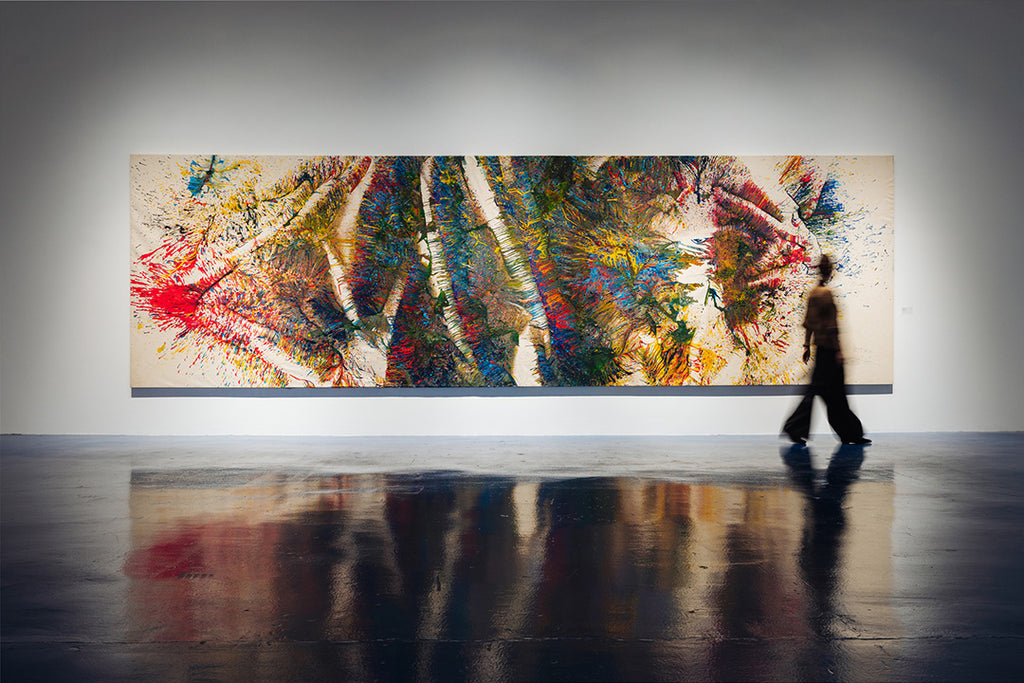ARTICLES
對伊藤加奈子的採訪 金山明與田中敦子創作基地所在的大阪妙法寺 與藝術家共同走過的出發點和終點(前篇)
GUTAI STILL ALIVE 2015 vol.1
26/35

Atsuko Tanaka drawing a picture at home(Myohoji), 1966, ©︎Ryoji Ito
本系列企劃為您推出關於具體美術協會的書籍《GUTAI STILL ALIVE 2015 vol.1》的數字檔案。第26期探討具體美術協會成員金山明與同為「具體」成員並同在1965年退出協會的田中敦子之間的相關性。這一對藝術家夫婦不僅在私生活方面,而且也在創作方面構築了密切的關係。兩位藝術家曾在大阪的妙法寺設立工作室。我們對該寺院的相關人士伊藤加奈子女士進行了採訪。
Myohoji, Osaka – The Departure and Arrival Point of Akira Kanyama and Atsuko Tanaka 01
The Insights of Kanako Ito: Part 1
具體美術協會成立兩年前的1952年,由一群青年藝術家等組成的革新藝術團體「0會」(又譯「零社」)宣佈成立。該團體有15名成員,白髮一雄、金山明、村上三郎名列其中。後來在金山明的推薦下,田中敦子也加入進來。
隨後,這四位藝術家受到具體美術協會成員嶋本昭三的邀請,成為「具體」的成員,並作為該協會具有代表性的藝術家參與了其活動。
金山明和田中敦子從「0會」時期便開始共同活動,隨後作為一對藝術家夫婦在一起生活。
在大阪有一個談起金山明、田中敦子和「0會」時不可或缺的地方,這就是擁有350年歷史的法華宗寺廟妙法寺,該寺廟位於大阪市中心的一個街區。前衛藝術家的活動與歷史悠久的寺廟聯繫在一起,也許會令人感到意外,但在這個寺廟的院內,曾經設有金山明和田中敦子的居所和小小的工作室。兩人的藝術活動就是從這裡開始的。據說在此之前,「0會」的會議也多次在這裡舉行。妙法寺見證了戰後新的美術即將誕生的勃勃生機。
如今,兩人曾經的居所兼工作室所在之處建起了安置亡故者牌位的「報恩堂」。金山明和田中敦子(本名金山敦子)的牌位也收在此處。也就是說,兩人奇跡般地又回到了曾經設有活動基地的妙法寺,而且還是工作室的原有位置。
這次採訪的對象是妙法寺曾經的住持伊藤良治先生的女兒伊藤加奈子女士。伊藤良治先生是金山明的弟弟。他曾擔任過當時沒有繼承人的妙法寺的住持,現在過著閒雲野鶴般的退休生活。目前的住持是加奈子女士的哥哥。
田中敦子在1965年退出具體美術協會之後,與此前一直共同活動的金山明一起,開始在金山居住的妙法寺內一處獨立的房屋生活,並在此創作作品。
伊藤加奈子:「金山明先生和田中敦子女士結婚後,住在妙法寺這裡的一座獨立房屋裡。當時,金山先生擔任學校老師,並把這裡作為基地從事各種活動。聽說在此很久以前,『0會』的聚會也曾在這裡舉行。我當時還沒出生,但聽祖母說她特別喜歡金山先生,為他提供了各種幫助。在介紹『0會』和金山夫婦的時候,人們總會提起這座寺廟的名字,但對我們來說,作為家人距離實在太近,因此說實話,他們在這兒究竟做了什麼,我們反而不得而知。」
「直到我7歲為止,金山先生和『小敦』(田中敦子)一直都住在這裡。那時,他們已經退出了「具體」。他們在寺廟內的那座獨立房屋召集了附近的孩子,主要由金山先生教書法和繪畫,而田中女士則一直專心畫畫。畫畫的人確實與普通人有所不同,我覺得一般人大概做不到那樣。田中女士平時十分文靜,但一旦拿起畫筆,就會讓人覺得不可思議:那麼小的身體竟然能創作出那麼宏偉的作品,其能量是從哪裡來的呢?真是太了不起了!她雖然在默默地作畫,卻有一種逼人的氣勢。總而言之,因為我從小就和她在一起,所以她叫我『小加奈子』,對我最寵愛。」
伊藤加奈子女士將田中敦子稱為「小敦」,這似乎是再自然不過的稱呼了,其中有家人般的感覺。在伊藤女士看來,金山和田中就相當於住在父親擔任住持的寺廟院內獨立房屋裡的伯父和伯母夫婦,她近距離地見證了兩人作為藝術家的生活方式。
加奈子女士從中感受到了金山明是如何認可田中敦子的才華,並努力創造條件,讓她更容易地創作作品的。田中敦子從京都市立美術大學輟學後,曾在大阪市立美術館附屬美術研究所學習,當時她與金山明已經相遇。據說就是在這個時候,在金山的建言之下,田中開始對抽象繪畫產生興趣。這一年輕時的相遇和影響一直延續了一生。在談論田中敦子時,金山明是不可或缺的存在,他一直在為田中的創作保駕護航。
伊藤加奈子:「金山先生的口頭禪是『跟別人一樣就沒意思。絕對要做跟別人不同的事情,否則就沒意思。』他一直特別重視是否有意思這一標準。田中女士完全依賴這樣的金山先生。(從妙法寺的獨立房屋搬到奈良縣的明日香村之後)每當金山先生來大阪的時候,都把這座寺廟作為中心從事各種活動。這個時候「小敦」也常常打來電話,跟金山先生商量著什麼。每當這種時候,金山先生總是指點迷津,告訴「小敦」這樣做或那樣做。不是有圓和線組成的畫嗎?是否要在上面加一條線,都是非常勞神費心的。所以那些作品絕對不可能是偶然形成的。全部都要有精心的素描,然後才上色。在素描階段就要苦思冥想地考慮是否要加上這條線。對此,金山先生會一邊說一邊指導她該怎麼做。這些都是通過電話進行的。此外,田中女士想要這種或那種色彩的顏料時,一切都是由金山先生安排的。與畫框店和畫廊的交涉也由金山先生負責。而且不僅僅是創作,生活的方方面面,所有的事情都由金山先生負責安排和處理。金山先生最優先考慮的就是讓田中女士能夠專注於創作。我曾經問過其他人,他們都說是金山先生慧眼識珠,看出了田中女士的才華,並一直對她進行引導。
「田中女士給人的感覺就是比較文靜而且只考慮繪畫。她的兄弟姐妹都說,只要『小敦』能心情愉快地畫畫,就可以了(笑)。即使家裡的紅白喜事,她似乎也總可以置身事外。」
在大阪的妙法寺開始作畫並參加「0會」,經歷了「具體」之後,金山明和田中敦子開始獨立活動。1972年他們從大阪的妙法寺搬到奈良縣的明日香村,在寧靜的住所和可以擺下大型作品的工作室里繼續從事創作。伊藤加奈子女士一直密切關注著他們的活動軌跡。這次她為我們講述了通過家人般的親密關係接觸到的二位藝術家的自然平實的真實面貌。
2005年3月田中敦子因交通事突然離世之際,在醫院照料她的也是伊藤加奈子女士。
(刊載於2014年8月的《月刊畫廊》雜誌)
(續篇接第28期)
文中提到的資訊是文章發佈當初的情況,某些部分也許已與現狀有所不同。



